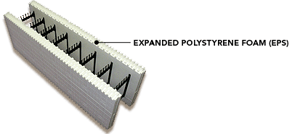Traditional masonry foundations do a good job of supporting the structure above them. However, as energy sponges that absorb any amount of energy thrown at them, there’s no denying that they also have some pretty serious limitations when it comes to green building. In addition, if the drainage around the foundation isn’t right, it may also transfer water into the home — aka a damp or wet basement.
So, at Meadowlark Design+Build, we’re much bigger fans of insulated concrete form (ICF) foundations. Let’s explore a little more about what ICFs are, and the pros and cons that come with them.
What Are ICF Foundations?
ICFs usually consist of molded expanded polystyrene (EPS) shells that stack together (think large Legos) to make foundational forms. When these forms are then filled with concrete, they make a poured masonry wall that is strong, moisture repellent and extremely energy efficient. Below, we’ve provided a picture of an EPS ICF block for reference:

The Cons of ICF Foundations
Since we know that it’s difficult to focus on the positives without thinking, “What’s the catch here?,” let’s start with the cons of ICF foundations.
They Require A Lot of Energy to Produce
Although ICFs have quite a few energy-efficiency benefits, they aren’t without environmental issues. For one thing, concrete takes a lot of energy to produce, mostly because 15% of concrete is composed of Portland cement. This material is basically a mixture of rocks and minerals (think limestone, clay, shale, sand, etc.) that are ground to a powder and heated in a kiln to about 1450 degrees Centigrade. However, the good news (and probably should be a "pro") is that compared to a traditional poured concrete foundation, the ICF foundation uses about 10% less concrete.
They Have a Polystyrene Shell
Another downside of ICF foundations is their polystyrene shell. Polystyrene is a petroleum by-product, and there are a slew of environmental reasons to avoid it.
The good news is, there are a few options you can use to avoid using polystyrene in your ICFs — the most popular being Durisol ICFs. More on Durisol ICFs in a later blog post.
You need to have them designed and installed by experienced professionals
Like almost any type of construction material, a great product can be improperly installed resulting in a not-so-great experience in the long run. Design considerations for additional ICF wall thickness along with proper installation and waterproofing all need to be discussed and managed by experienced professionals. At Meadowlark we built our first ICF Home in 2006 and it received LEED Platinum certification by the US Green Building Council.
The Pros of ICF Foundations
Aside from those cons, ICF foundations provide many benefits over traditional masonry foundations. It’s why we like them, use them, and advocate for them over here at Meadowlark. Below are the four main advantages of ICFs that we’ve discovered.
They’re Amazing Heat Retainers
Traditional, uninsulated masonry walls typically have an R-1 insulation value, which is about the same as a single pane of glass. In contrast, ICF foundations have an R-25 insulation value, which makes it an incredible heat retainer for a comfy, cozy home.
They Work Well for Exterior Walls
Not only do ICFs work well for foundations, but they make strong, tight exterior walls as well! In fact, many mid-rise hotels — particularly those in hurricane-prone areas — are built with ICFs. So, if you’re looking to build a home with an amazing envelope that will withstand extreme environmental conditions, this is definitely one method you’ll want to keep in mind.
Improved Indoor Air Quality
ICF exterior walls are tighter and more dense than traditional stick-framed walls which means that less air can move through the exterior envelope of your home. The obvious result of this is a reduction in your energy cost, but another benefit is that the structure can also reduce dust and allergen pollution in your home significantly.
They are quieter
According to a study done by ICF Builder Magazine, ICF homeowners who had used ICF's in their exterior wall construction noted that "sound attenuation as one of the most appreciated benefits." The other top 3 were energy efficiency, disaster resistance (see below) and comfort.
They’re Stronger and Highly Durable
ICFs are highly durable. How durable, you ask? Check out these images of various disasters:
This is a photo of a housing development in San Bernardino, California after a 2007 wildfire swept through the area.
The beachfront home on the right survived Hurricane Sandy, while its immediate neighbors suffered complete losses.
And here is a story about how an ICF home withstood Hurricane Michael in the Florida Panhandle.
Interested in learning more about ICF construction? Give us a call at 734-443-1500, or fill out our contact form. We'd love to start the conversation.
